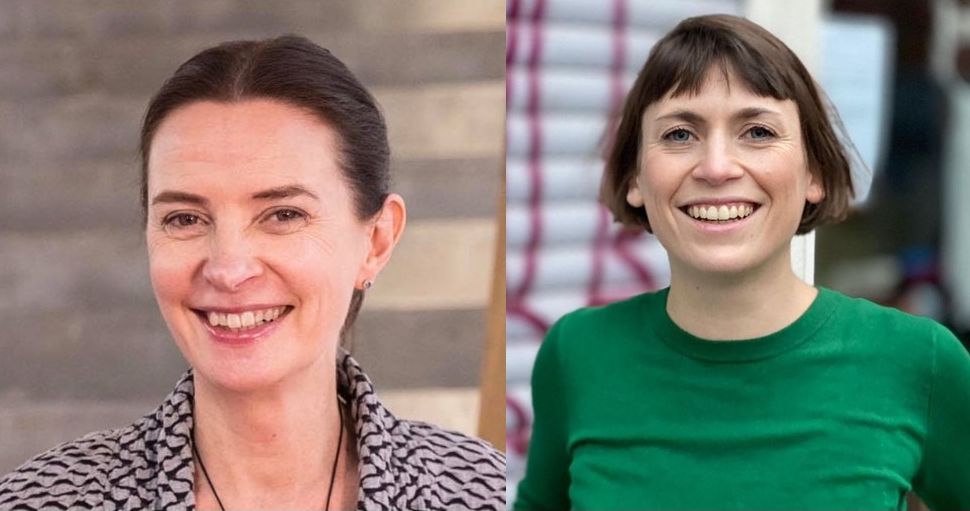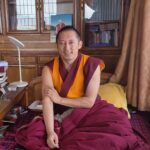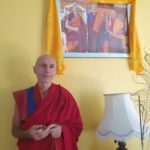Anne Brunila from Finland and Amrei Vogel from Germany joined the Council of Association Shenten Dargye in 2021. This is their story with Bön.
Anne: With Bön, my practice and meditation has developed
My spiritual journey began when I was 16 and learned about Buddhism at school. At that moment, I had a strong feeling that I found something very precious for my life, and a place where I belonged. Everything I read resonated strongly with me. Since I wanted to understand emotions and thinking; how the mind works; what is the reality; what is the meaning of life and how to find true peace and happiness in one’s mind, it is no wonder that I became deeply motivated to learn more about Buddhism.
I spent much time reading all the Buddhist texts and books which I could find in libraries and bookshops. Very soon I realized that I felt most connected to Tibetan Buddhism and the teachings of great Tibetan masters like Longchenpa, Gampopa, Patrul Rinpoche, Kalu Rinpoche, Dilgo Khyentse, Namkhai Norbu, and of course, His Holiness the 14th. Dalai Lama. This reading gave me some basic understanding of Buddhist philosophy and the science of the mind. The more I read the more I wanted to learn and hoped that some day I would find a teacher and begin practicing.
I met my first teacher, Tarab Tulku Rinpoche, in the late 1980’s, and it was then that I began practicing daily. During the retreats Rinpoche explained the foundations of Buddhist philosophy, practice and meditation. I was his student for some years but left when he established a four-year training program on Buddhist psychology in Sweden. At that point we were a small group of practitioners pondering how to find a new teacher. We were taught that the most important thing is to make sure that the teacher is qualified. With this in mind, we decided to follow the teachings and initiations given by His Holiness the Dalai Lama in various European countries and the US. I received my first Dzogchen teaching and initiation from His Holiness in 2000, in Montpellier, France.
In 2000 I moved to Brussels and found my way to Rigpa, and began going to Sogyal Rinpoche’s teachings and doing the Ngöndro according to the Nyingma tradition. I also became interested in Chögyal Namkhai Norbu’s teachings and took part in his summer retreats in Merigar, Italy. Because I had a strong belief that my disabled son, too, had a connection to Tibetan Buddhism, I took him with me. He first met some Tibetan monks and doctors a few years earlier, in a big exhibition of Tibetan culture in Helsinki. On that occasion four monks from Namgyal monastery were making the Kalachakra sand mandala, and after they had finished, four other monks made another big sand mandala. My son was so enthusiastic about the monks’ work that I had to bring him frequently back to the museum where the monks were happy to see him. Since then he has felt very easy and close to all the Tibetan monks and lamas he has met.
I think it was 2009 when I first heard about Bön from friends who had been to Tenzin Wangyal Rinpoche’s teachings. As soon as I heard the words “Bön” and “Tenzin Wangyal”, it gave me a real thrill and I instantly realized that Bön is my tradition. Later, I found out that “Tenzin Wangyal” was also the name of Shardza Tashi Gyaltsen’s master, and maybe it was because of this that I got some kind of inexplicable déjà-vu experience when hearing the name.
I wanted to attend Tenzin Wangyal Rinpoche’s teachings as soon as I could to learn about Bön. I listened to his online teachings and when he came to Europe, I flew to Berlin to his Bardo teachings. The timing turned out to be especially indispensable: my father passed away only two months after the teachings and I still had them fresh in memory and could do the prayers and practices for him. I had already received Bardo teachings from Sogyal Rinpoche ten years earlier, shortly before my mother passed away. Thanks to the teachings I was able to assist her during the death process and do Bardo prayers for her.
In 2014 I got to know about Yongdzin Rinpoche and Shenten Dargye Ling. This was very fortunate because in the summer retreat Rinpoche started to teach the Twenty-One Nails (Zerbu) with Khenpo Tenpa Yungdrung Rinpoche. Meeting Yongdzin Rinpoche and Khen Rinpoche was a life-changing experience for me. My practice and meditation developed more after that retreat than during all the previous years. I was so happy that I had finally found my heart teachers and the lineage. In the same year I also met my third heart teacher Khenpo Gelek Jinpa. I sometimes felt sorry that I had not found Bön and my precious teachers earlier, but this was my Karma. Yet I understand how fortunate I had been!
Encouraged by Khenchen Rinpoche we founded a Bön association and Sangha called Dechen Ritrö in 2016. This very auspicious name was given by Yongdzin Rinpoche, the same name as Sharda Rinpoche’s famous retreat place in Tibet. We organized Khenpo Gelek’s teachings since 2014 on Gyalwa Chagtri, and Khencen Tenpa Yungdrung Rinpoche’s teachings on Shardza Rinpoche’s Heart Drops of Dharmakaya (Künzang Nyingtik) since 2018 in Helsinki, and recently on zoom too. Geshe Lungrik gave us teachings on the Medicine Buddha practice. Via zoom we have been able to open these wonderful teachings to Sanghas across the world.
During the past year I, together with a friend, translated Shardza Rinpoche’s text into Finnish. Upon Khenpo Tenpa Rinpoche’s suggestion, and with Philippe Cornu’s kind permission, we used his French translation for this purpose. The book has just been published and my wish is that it will be of benefit to the Finnish practitioners and to everybody interested in Dzogchen.
Amrei: I wanted to understand what I practice
I just finished my studies of Central Asian Studies at Humboldt-Universität in Berlin, with a focus on Tibetan culture and anthropological methods. My final thesis was about death rituals in a Bön community in Dolpo, Nepal. How did it come about that my university studies and my path as a practitioner converged? I think that my parents played a role in it. My mother has a very critical mind, in a healthy, positive way, and she always encouraged me to understand deeply what I do; what I pursue; what I commit myself to; to explore systematically what I feel as a choice of my heart. Practically speaking, I wanted to understand words in prayers that I recite and so I started learning Tibetan. I also wanted to know the historical and cultural background of the spiritual school that has become so important for my personal growth. I wished to see places connected historically and culturally with Bön, so I went to Nepal. My life has gradually been permeated with curiosity and interests related to Yungdrung Bön.
Then I found a scholar here at the university in Berlin, Prof. Dr. Huber, who also did research on Bön, mainly as the pre-Buddhist culture in Tibet,. Also, Khenpo Tenpa Yungdrung´s suggestions were very important to me, and he supported my plans. I shared with him that I was not sure about what I should focus my master’s thesis on, and he said: you could go to Dolpo in Nepal.It is an area where people are still practicing very ancient rituals connected to death and dying. I went there, in 2016 for the first time, and I started exploring the death rituals in one village. I returned several times and based my thesis on what I found and experienced there.
I have been connected with Bön my whole life, because it has been rooted in my family. My father was a practitioner for decades. Originally, he was a student of Chogyal Namkhai Norbu.Then, in the early nineties, maybe in the 1991 when I was born, he met Yongdzin Rinpoche for the first time and became his student. As a child I went with my father to teachings of both masters and he told me that I was very curious and paid attention to the teachings. Our house itself is a meditation center for the Dzogchen community of Namkhai Norbu´s students, the Yungdrung Bön Sangha, as well as various other Zen and yoga groups.
From about 2001, Khenpo Tenpa Yungdrung and Khenpo Gelek started to come to our home annually, and the fact that they were, in a way, part of my home created a close connection with the teaching, which grew slowly. When I was twenty three, I started practicing. I had just finished my bachelor degree and I did not want to continue to master studies right away. Instead, I wanted to go abroad, but not just to travel, I wished to work, to be useful somehow, and I asked my parents what I could do. My father said: you could go to Nepal, we know people there. I also asked Khenpo Tenpa Yungdrung, when he came to teach at our place, if he had some work for me in Nepal, and he said, yes, just come, we will find something.
In November 2014 I went to Kathmandu for the first time. I stayed in the guesthouse of Triten Norbutse for a period. It was the first timestudents of the boarding school in Lubrak, a village in Mustang, had enough money, given by a sponsor, to spend their winter holiday in Kathmandu. Khenpo Tenpa Yungdrung introduced me to them and to Norbu, the monk who was taking care of them. I then began teaching them English and some social studies. This is how I spent that winter. When they went back to their village, I joined them. It was my first time in a Bönpo village in the Himalayas. I established a close connection with the students and this made me come back again and again.
Afterwards, Amrei helped the boarding school of Lubra. Read the story here.












